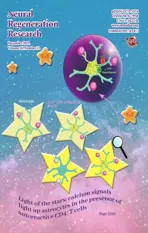CD4+ Tregs may be essential for solving astrocyte glial scar deadlock
2021-04-29MichelEdwarMickaelNorwinKubick
Michel Edwar-Mickael, Norwin Kubick
Glial scar is at the heart of the insolvability of spinal cord injury riddle. Spinal cord injury constitutes one of the worst fears for many active individuals. In addition to its economic burden on the global health system, this injury represents a fate of permanent disability for millions of patients who before their injury enjoyed a mobile lifestyle (Silver and Miller,2004; Yang et al., 2020). Unfortunately, once severed, the central nervous system axons are not capable of regeneration. The main barrier to regeneration attempts is the formation of a glial scar layer which consists mainly of astrocytes.
Astrocytes forming the glial scar employ three mechanisms to inhibit regeneration.(i) They form a physical barrier that prevents regeneration attempts by neurons. (ii)Astrocytes also produce chondroitin sulfate proteoglycans (CSPG) which inhibit neural growth. Although other cell types such as macrophages and oligodendrocytes similarly produce CSPG, astrocytes are considered one of the main resources of these proteoglycans.CSPGs bind to leukocyte common antigenrelated phosphatase and in turn inhibit neural axonal growth through inactivating Akt and activating RhoA signals (Fisher et al., 2011).A similar pathway is used by CSPGs to inhibit neural regeneration through binding to the redundant nogo receptor family members NgR1 and NgR3 (Dickendesher et al., 2012). CSPGs can also inhibit neural regeneration through binding to protein tyrosine phosphatasesigma. This was demonstrated by efficient neural growth of the corticospinal tract in protein tyrosine phosphatase-sigma knockout mice in the presence of CSPG (Chien and Ryu,2019; Dyck et al., 2019). (iii) Certain astrocytes subpopulations such as A1 were shown to be neurotoxic. A1 astrocytes have been revealed to eradicate neuronsin vitro(Liddelow et al., 2017). They have also been shown to accumulate around the lesion core during spinal cord injury (Qian et al., 2019). Interestingly, it was demonstrated that inflammatory factors play a critical role in increasing the activation of the A1 subtype, hinting towards a previously unknown role for the immune response during spinal cord injury (Qian et al., 2019).
CD4+Tregs constitute a new hope to inhibit excess A1 astrocytes activation. CD4+helper T cells are a versatile group of cells consisting of a large spectrum of various populations (Mickael et al., 2020). CD4+Th1 and CD4+Th17 are proinflammatory and have been shown to increase astrocyte reactivity during neuroinflammatory diseases (Kubick et al., 2020). Conversely,CD4+Tregs are known to perform a regulatory function and a neuroprotective role (Bhaumik and Basu, 2017). Interestingly, using adoptive transfer of Treg in mice devoid of CD3e, it was shown that wild-type but not amphiregulin knockout Tregs cells could suppress excess astrogliosis. Furthermore, it was demonstrated that amphiregulin suppressed interleukin (IL)-6 induction in astrocytesin vitroand inhibited phosphorylation of STAT3 in ischemic mice brainsin vivo(Ito et al., 2019). Furthermore,administration of anti-IL6R reduced astrogliosis in DEREG (Tregs depleted) mice (Ito et al.,2019). These observations suggest that Tregs are capable of inhibiting astrogliosis through suppressing the IL6-STAT3 pathway by producing amphiregulin (Figure 1).
Collectively, therapeutically applying Tregs at the lesion core after spinal cord injury could prove to be an important strategy in rescuing the ability of neural regeneration. Future experiments are needed to validate this argument and also to investigate the dynamics of the glial scar formation, astrocytes accumulation and CSPG production in terms of the interactions between Tregs and A1 astrocytes on a single-cell level(Kubick et al., 2020).
We would like to acknowledge the ideas and the directions of Macrious Abraham and Mary Joachim (PM Forskningscentreum, Sweden).
Michel Edwar-Mickael*, Norwin Kubick
Department of Experimental Genomics,Institute of Animal Biotechnology and Genetics,Polish Academy of Science, Jastrzebiec,Poland; Department of Immunology, PM Forskningscentreum, Ekerö Stockholm, Sweden(Edwar-Mickael M)Institute of Biochemistry, Molecular Cell Biology,University Clinic Hamburg-Eppendorf, Hamburg,Germany (Kubick N)

Figure 1|CD4+ Tregs could play a positive role in inhibiting activated astrocytes during spinal cord injury.
*Correspondence to:Michel Edwar-Mickael,michel.edwar77@gmail.com.https://orcid.org/0000-0002-4186-4900(Michel Edwar-Mickael)
Date of submission:October 29, 2020
Date of decision:December 14, 2020
Date of acceptance:March 29, 2021
Date of web publication:April 23, 2021
https://doi.org/10.4103/1673-5374.313069
How to cite this article:Edwar-Mickael M,Kubick N (2021) CD4+ Tregs may be essential for solving astrocyte glial scar deadlock. Neural Regen Res 16(12):2563.
Copyright license agreement:The Copyright License Agreement has been signed by both authors before publication.
Plagiarism check:Checked twice by iThenticate.
Peer review:Externally peer reviewed.
Open access statement:This is an open access journal, and articles are distributed under the terms of the Creative Commons Attribution-NonCommercial-ShareAlike 4.0 License, which allows others to remix, tweak, and build upon the work non-commercially, as long as appropriate credit is given and the new creations are licensed under the identical terms.
杂志排行
中国神经再生研究(英文版)的其它文章
- Inhibition of extracellular vesicle pathway using neutral sphingomyelinase inhibitors as a neuroprotective treatment for brain injury
- Neuroglobin and neuroprotection: the role of natural and synthetic compounds in neuroglobin pharmacological induction
- Potential effects of mesenchymal stem cell derived extracellular vesicles and exosomal miRNAs in neurological disorders
- Epidural electrical stimulation for spinal cord injury
- Localization of the hydrogen sulfide and oxytocin systems at the depth of the sulci in a porcine model of acute subdural hematoma
- Lithium beyond psychiatric indications: the reincarnation of a new old drug
